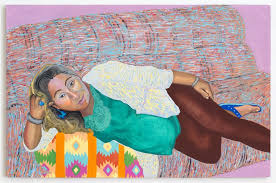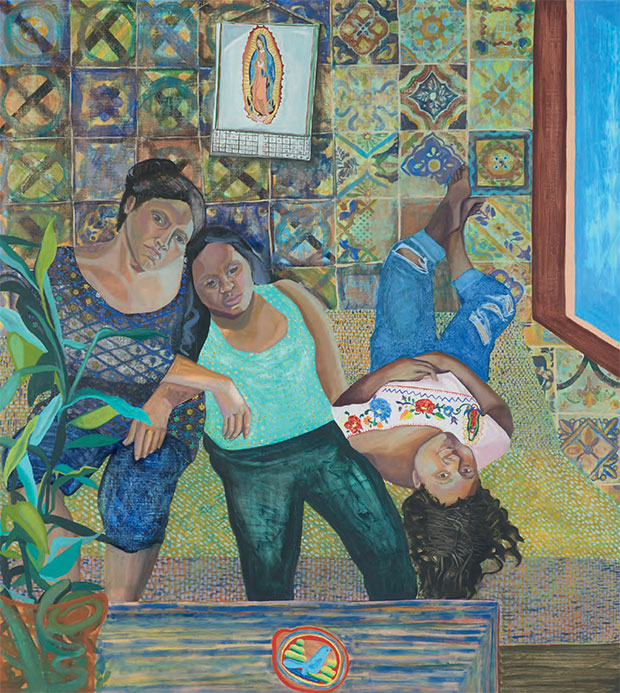Artistfacts: Aliza Nisenbaum

A young artist, do we still use the word emerging, with her first solo museum exhibition going on right now at the Minneapolis Institute of Art. Aliza Nisenbaum’s work was also included in the 2017 Whitney Biennial and an exhibit at the Flag Art Foundation that same year, so as you see getting a lot of attention. Aliza is a figurative painter and is described as a political painter, born in 1977 in Mexico City Mexico, currently working in New York. She got her MFA and BFA from the Art Institute of Chicago. She teaches at Columbia. Ok so not so young.

In 2010/2012, Aliza participated in the Immigrant Movement International, a project run by Tania Bruguera, the Cuban activist/artist, project which was commissioned by Creative Time and the Queens museum. It is the works from this period that started the marked interest in here practice. InitiallyAliza taught English through feminist art history which in and of itself is an interesting idea as to what the best way to engage with a community of largely undocumented Latin American women is, these women being the primary participants in the project. Over time, as Aliza began to better know and befriend these women, she decided to paint them and invited them to be painted by her. This quid-proquo is important. Aliza Nisenbaum’s work does not separate the artist, the viewer and the sitter. Her paintings are very intimate and caring. They invite you into the living space of the sitter. They are a result of a strong and intense relationship that she has with the sitters and the community they are from. She establishes trust, pays the sitters for their time and at times gifts a painting to a regular sitter. She visits their homes, invites them hers, talks with them, engages.

The works are intimate, the colors are soft, although somewhat referent to the Mexican muralists. The perspective is off. There are no strident textual messages writ large over the canvases. So why are her works deemed to be political? Why is she seen as being engaged in “Social Practice Art” ? Because she actively engages with different populations. These are not figurative works of her family, her home, her friends. The work emerges out of the relationships she builds with people. How they want to be portrayed. Because she is painting people who are usually invisible, yet within the paintings she often includes elements of their tradition and elements of their histories, providing a careful viewer, one who looks at the details of the painting, clues to the forces that made the sitter who they are, their pasts, their interests, their traditions, their dreams.

Aliza Niesenbaum believes that painting a person gives that person a voice and that that voice must be given dignity and pride of place. You must be “ethical”, a term she uses a lot in your portrayal. In a world where images are ubiquitous, transformed to create whatever reality the maker of the image wants, she attempts, generally successfully, to give the sitter, sitter who often is not powerful or wealthy, sitter who is in so many ways an unknown, invisible cog in a system, a presence and a humanity, a face one wants to know and befriend.
During her artist in residency program at the Minneapolis Institute of Art, prior to the current show entitled ” A Place We Share”, she painted the guards, a reflection on the entry point to the museum, an institutionalized criticism of a museum, criticism here not meant or used as a possible negative but more as an analysis and, once again portrayed a group that is largely invisible and ignored. She then continued to meet, befriend and depict various community and neighborhood groups including muslim women.

A non figurative series reproduces letters from a friend who spend two years in prison. Some of the text is legible, some not. Drawing you close but maintaining the dignity and privacy of the writer. Honest and true, based on reality. Portrayal without a body.
I believe that biographical details are important in understanding an artist’s work, particularly in the world today but less so in Aliza Nisenbaum’s work. Aliza Nisenbaum was born and raised in Mexico Her mother was Norwegian American and her father Russian Mexican and at one point she studied psychology. However, other than speaking Spanish, being an immigrant and not belonging to any one culture therefore being open to differences, her background does not seem to be important to her current body of work. She is more interested in giving pride of place to the sitters. This comment is probably not true of her earlier works of flowers, which she would render to scale that may have referenced her mother.

In my opinion Aliza Nisenbaum is an interesting artist to follow. In a time of strident, in your face political and large, often loud statement paintings, she has a very different voice and sensibility, one that could easily be lost which would be a great pity, at the same time, she, in my opinion, cannot, should not, become an easily absorbed painter, where the message is lost in the technique and beauty of the work. I look forward to seeing much more.
I must thank her for making a lot of the pictures of the work available on the internet for me to share with you.






Thanks again for an interesting profile. I remember walking through her rooms at the Whitney Biennial and remarking on the scale of the paintings, the large figures. Obviously noticing that it’s figurative but I never understood how important it was that she got under the skin of her subjects and really honored them. I will look again I love the way you take the time to translate art works for me. Thank you.
Nadia Zilkha Laetitia Vineyard Nadia@laetitiawine.com
>
LikeLike